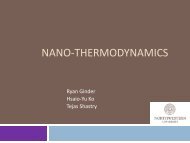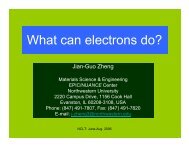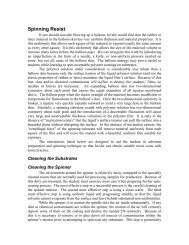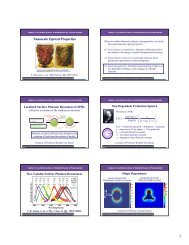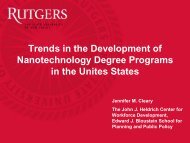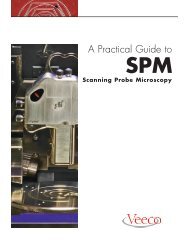Nano-magnetism - NCLT
Nano-magnetism - NCLT
Nano-magnetism - NCLT
Create successful ePaper yourself
Turn your PDF publications into a flip-book with our unique Google optimized e-Paper software.
<strong>Nano</strong><strong>magnetism</strong><br />
Kristen Buchanan<br />
Materials Science Division<br />
and<br />
Center for <strong>Nano</strong>scale Materials<br />
Argonne National Laboratory<br />
<strong>NCLT</strong> <strong>Nano</strong>workshop<br />
July 28, 2006
<strong>Nano</strong>science & <strong>Nano</strong>technology<br />
• What is nanoscience? <strong>Nano</strong><strong>magnetism</strong>?<br />
• Why is it interesting?<br />
• How do we make nanoparticles?<br />
• How can we see them?<br />
• What does the future hold?<br />
Single Atom<br />
Bulk Material<br />
<strong>Nano</strong>cluster<br />
<strong>NCLT</strong> <strong>Nano</strong>-workshop, Argonne National Laboratory<br />
July 28, 2006
<strong>NCLT</strong> <strong>Nano</strong>-workshop, Argonne National Laboratory<br />
July 28, 2006<br />
What Are “<strong>Nano</strong>materials”?<br />
Definition based on structure<br />
Structure is different from what you<br />
get in bulk materials<br />
Definition based on properties<br />
Properties are different from what<br />
you get in bulk materials<br />
yellow silver<br />
yellow silver<br />
Structured on a scale of ~10-1000 atoms<br />
Arrays of gold nanoparticles<br />
Kiely et al. Nature 396, 444 (1998).<br />
red gold<br />
Properties different from atoms or<br />
molecules, different from bulk<br />
Yellow silver nanoparticle sample.
When did the nano-revolution begin?<br />
“There’s Plenty of Room<br />
at the Bottom”<br />
Cup of Lycurgus: 4th century A.D.<br />
British Museum<br />
• Richard Feynman’s speech in 1959<br />
• Key to progress: better tools<br />
http://www.thebritishmuseum.ac.uk/science/lycurguscup/sr-lycugus-p1.html<br />
<strong>NCLT</strong> <strong>Nano</strong>-workshop, Argonne National Laboratory<br />
July 28, 2006
<strong>Nano</strong><strong>magnetism</strong><br />
• Create<br />
• Explore<br />
• Understand<br />
• Ancient times: Greeks and Chinese discovered<br />
an iron-rich mineral known as lodestone<br />
•Early compass 1000 AD<br />
1600: Diagram from William Gilbert’s<br />
book "De Magnete” or “On the Magnet”<br />
Present day: Magnetic<br />
vortex in a micron-sized dot<br />
<strong>NCLT</strong> <strong>Nano</strong>-workshop, Argonne National Laboratory<br />
July 28, 2006
Magnets in Everyday Life<br />
• Permanent Magnets<br />
Motor<br />
http://fly.hiwaay.net/~palmer/motor.html<br />
Magnitude 9.0 Earthquake, Northern Sumatra,<br />
December 26, 2004<br />
U.S. Geological Survey, National Earthquake<br />
Information Center<br />
http://www.howstuffworks.com/<br />
<strong>NCLT</strong> <strong>Nano</strong>-workshop, Argonne National Laboratory<br />
July 28, 2006
<strong>NCLT</strong> <strong>Nano</strong>-workshop, Argonne National Laboratory<br />
July 28, 2006<br />
Magnets in Everyday Life<br />
• Storage Media<br />
Magnetic tracks on a 5 Gb hard drive<br />
(http://www.pacificnanotech.com/mag<br />
netic-microscopy_single.html)<br />
• Medical: MRI<br />
40 μm<br />
In 2003, there were ~ 10,000 MRI units<br />
worldwide, and ~ 75 million MRI scans performed.
Moore’s Law<br />
Year<br />
<strong>NCLT</strong> <strong>Nano</strong>-workshop, Argonne National Laboratory<br />
July 28, 2006
<strong>NCLT</strong> <strong>Nano</strong>-workshop, Argonne National Laboratory<br />
July 28, 2006<br />
<strong>Nano</strong><strong>magnetism</strong> & Spintronics<br />
• Giant Magnetoresistance (GMR)<br />
Electron:<br />
- -<br />
High Resistance<br />
Low Resistance<br />
G. A. Prinz, Science 282, 1660, 1998<br />
40 μm
MRAM<br />
• Instant-on computers<br />
• Tiny, reliable portable<br />
devices<br />
– Cell phones<br />
– MP3 players<br />
http://www.research.ibm.com/<br />
<strong>NCLT</strong> <strong>Nano</strong>-workshop, Argonne National Laboratory<br />
July 28, 2006
<strong>NCLT</strong> <strong>Nano</strong>-workshop, Argonne National Laboratory<br />
July 28, 2006<br />
Bio- + Magnetic = ♥<br />
The magnetic nature of particle is used as a mechanism for:<br />
•Targeted delivery<br />
•Detection<br />
•Manipulation<br />
•Functional control<br />
Bio-??? OF INTEREST<br />
MAGNETIC NANOPARTICLES
<strong>NCLT</strong> <strong>Nano</strong>-workshop, Argonne National Laboratory<br />
July 28, 2006<br />
How do we build nanomaterials?<br />
• Lithography<br />
• Chemical synthesis, self-assembly
Fabrication: Top-Down<br />
Polymer<br />
“PMMA”<br />
Plexiglas<br />
Spin Coat<br />
Expose<br />
Develop<br />
Metallization<br />
Lift-off<br />
1 μm<br />
<strong>NCLT</strong> <strong>Nano</strong>-workshop, Argonne National Laboratory<br />
July 28, 2006
<strong>NCLT</strong> <strong>Nano</strong>-workshop, Argonne National Laboratory<br />
July 28, 2006<br />
Bottom-up: Self-assembly<br />
• Self-assembled 3D arrays of 6-nm FePt particles<br />
S. Sun, C. B. Murray, D. Weller, L. Folks, A. Moser, Science 287, 1989, 2000
<strong>NCLT</strong> <strong>Nano</strong>-workshop, Argonne National Laboratory<br />
July 28, 2006<br />
<strong>Nano</strong>-Biology<br />
Biology uses nano<br />
<strong>Nano</strong>fabrication using<br />
biology<br />
Remove<br />
DNA<br />
Replace<br />
• Chains of nanomagnets in<br />
magnetotactic bacteria<br />
Dunin-Borkowski et al., Science, 282, 1868, 1998<br />
40 nm<br />
• Magnetic Viruses<br />
Liu et al. J. Magn. Magn. Matter. 2006
Virtual Fab: Micromagnetic Simulations<br />
1.0<br />
(e)<br />
M<br />
H<br />
Magnetization, M/Ms<br />
0.5<br />
0<br />
-0.5<br />
(c)<br />
(d)<br />
-1.0<br />
(a)<br />
(b)<br />
Field, mT<br />
-150 -100 -50 0 50 100 150<br />
H<br />
H<br />
(a) (b) (c) (d) (e)<br />
• Landau-Lifshitz Gilbert equation: dynamic relaxation with damping<br />
OOMMF Project http://math.nist.gov/oommf/<br />
<strong>NCLT</strong> <strong>Nano</strong>-workshop, Argonne National Laboratory<br />
July 28, 2006
<strong>NCLT</strong> <strong>Nano</strong>-workshop, Argonne National Laboratory<br />
July 28, 2006<br />
How can we “see” nanoparticles?<br />
• Optical microscope:<br />
– Can resolve > 1 μm (1000 nm)<br />
– Diffraction-limited<br />
∝<br />
• Resolution wavelength<br />
• Solutions:<br />
– Near-field optics<br />
– Use smaller wavelengths<br />
• X-rays<br />
• Electrons<br />
– Scanning-probe microscopy
<strong>NCLT</strong> <strong>Nano</strong>-workshop, Argonne National Laboratory<br />
July 28, 2006<br />
Magnetic Imaging<br />
N<br />
S<br />
N<br />
S<br />
• Iron fillings show magnetic field lines: early 19th-century imaging tool Freeman<br />
and Choi, Science 294, 1484, 2001
Magneto-optical methods<br />
• Magneto-optical Faraday (transmission)<br />
and Kerr (reflection) effects<br />
– Discovered in 1845 (Faraday) and<br />
1888 (Kerr)<br />
– Rotation in polarization proportional to<br />
magnetization<br />
– Imaging<br />
– Hysteresis<br />
15 μm<br />
Th. Lacoste, Th. Huser and H. Heinzelmann,<br />
Z. Phys. B 104, 183, 1997<br />
<strong>NCLT</strong> <strong>Nano</strong>-workshop, Argonne National Laboratory<br />
July 28, 2006
Side View<br />
Transmission Electron Microscopy<br />
λ ~ 0.0025 nm<br />
3 mm<br />
4 nm<br />
20 nm<br />
Fe <strong>Nano</strong>crysals in SiO 2<br />
Buchanan et al. <strong>Nano</strong>. Lett. 2005<br />
<strong>NCLT</strong> <strong>Nano</strong>-workshop, Argonne National Laboratory<br />
July 28, 2006<br />
Volkov and Zhu, Ultramicroscopy 98, 271, 2003
CNM <strong>Nano</strong>probe at the Advanced<br />
Photon Source<br />
<strong>NCLT</strong> <strong>Nano</strong>-workshop, Argonne National Laboratory<br />
July 28, 2006<br />
30 nm beam: Fresnel zone plate
Photoemission Electron Microscopy (PEEM)<br />
• X-rays and electrons:<br />
– Shine x-rays on sample<br />
– Capture emitted electrons<br />
• Element-specific<br />
• High resolution (50-100 nm)<br />
PEEM images of 1-2 μm tri-layer<br />
nanomagnets (Advanced Light Source)<br />
Buchanan et al. Phys. Rev. B, 72, 134415, 2005<br />
<strong>NCLT</strong> <strong>Nano</strong>-workshop, Argonne National Laboratory<br />
July 28, 2006
Atomic Force Microscopy<br />
AFM image of ferroelectric stripe domains<br />
10nm PbTiO 3 on SrTiO 3<br />
Magnetic vortices in a patterned<br />
ferromagnet<br />
100nm<br />
http://www.msd.anl.gov/<br />
Buchanan et al. Nature Physics 2006<br />
<strong>NCLT</strong> <strong>Nano</strong>-workshop, Argonne National Laboratory<br />
July 28, 2006
Scanning Tunneling Microscopy<br />
http://en.wikipedia.org/wiki/Scanning_tunneling_microscope<br />
• Scan atomically-sharp tip over sample<br />
• Record height/tunneling current information<br />
<strong>NCLT</strong> <strong>Nano</strong>-workshop, Argonne National Laboratory<br />
July 28, 2006
Scanning Tunneling Microscopy<br />
Quantum Corral (IBM)<br />
Writing with Atoms<br />
Eigler & Schweizer, Nature, 1990)<br />
1981: G. Binnig and H. Rohrer (IBM) invented the scanning tunneling microscope<br />
1986: Nobel Prize in Physics:<br />
G. Binnig and H. Rohrer for STM<br />
E. Ruska for designing the first electron microscope<br />
<strong>NCLT</strong> <strong>Nano</strong>-workshop, Argonne National Laboratory<br />
July 28, 2006
Spin Polarized Scanning Tunnelling Microscopy<br />
• Mn monolayer on W(110) measured with a magnetic Fe tip<br />
• Atomic resolution<br />
• Periodic parallel stripes along the [001] direction: antiferromagnetic<br />
configuration (Nolting et al., Nature 405, 767, 2000)<br />
<strong>NCLT</strong> <strong>Nano</strong>-workshop, Argonne National Laboratory<br />
July 28, 2006
Magneto-transport<br />
• Electrical contacts can be attached to<br />
nanomagnets<br />
– Reversal in single element<br />
– Spin transport<br />
Py<br />
Au<br />
1 μm<br />
<strong>NCLT</strong> <strong>Nano</strong>-workshop, Argonne National Laboratory<br />
July 28, 2006<br />
Y. Ji, A. Hoffmann, J. S. Jiang, S. D. Bader,<br />
Appl. Phys. Lett. 85, 6218, 2004
Freezing Time: <strong>Nano</strong>seconds and beyond<br />
• Famous photo by H. Edgerton<br />
– Flash photography: microseconds<br />
<strong>NCLT</strong> <strong>Nano</strong>-workshop, Argonne National Laboratory<br />
July 28, 2006
Pump-probe dynamics<br />
<strong>NCLT</strong> <strong>Nano</strong>-workshop, Argonne National Laboratory<br />
July 28, 2006
Pump-probe dynamics<br />
• Dynamics of <strong>Nano</strong>magnets:<br />
<strong>NCLT</strong> <strong>Nano</strong>-workshop, Argonne National Laboratory<br />
July 28, 2006<br />
– Probe: 0.100 ps (0.1x10 -12 s) laser pulse<br />
– Pump: trigger current pulse in waveguide
<strong>NCLT</strong> <strong>Nano</strong>-workshop, Argonne National Laboratory<br />
July 28, 2006<br />
Time-Resolved Magnetic Imaging<br />
Reversal field<br />
H t<br />
• 10 by 2 µm rectangles of 15-nm thick nickel-iron (Ni 80<br />
Fe 20<br />
)<br />
Freeman and Choi, Science, 294, 1484, 2001
Where will nano make an impact?<br />
Electronics<br />
– Information storage &<br />
processing<br />
– Spintronics<br />
– Photonics<br />
Materials<br />
– Powders, coatings,<br />
composites<br />
– Harder, stronger, dirt<br />
Security<br />
repellant, …<br />
– Sensors<br />
– Protective clothing<br />
– Communications<br />
Energy/Environment<br />
– Solar cells<br />
– Fuel cells<br />
– Remediation<br />
Bio-Medical<br />
– New materials<br />
– Drug delivery<br />
– Diagnostics<br />
<strong>NCLT</strong> <strong>Nano</strong>-workshop, Argonne National Laboratory<br />
July 28, 2006
Conclusions<br />
• <strong>Nano</strong>science<br />
– Create<br />
• Lithographic patterning, self-assembly, …<br />
– Explore and Understand<br />
• Experiment: imaging, dynamics<br />
• Simulation/Theory<br />
– Exciting fundamental research<br />
– New and improved technologies for the future<br />
Center<br />
for<br />
<strong>Nano</strong>scale Materials<br />
at Argonne<br />
<strong>NCLT</strong> <strong>Nano</strong>-workshop, Argonne National Laboratory<br />
July 28, 2006
Further Information<br />
• “When Things Get Small”: 30 min. TV show, 5 Emmy Awards!<br />
– http://www.uctv.tv/getsmall/<br />
• “There’s Plenty of Room at the Bottom”, Feynman’s lecture from 1959<br />
– http://www.zyvex.com/nanotech/feynman.html<br />
• http://nano.anl.gov/<br />
• http://www.discovernano.northwestern.edu/<br />
• National Center for Learning and Teaching of <strong>Nano</strong>scale Science and Engineering<br />
– http://www.nclt.us<br />
• National <strong>Nano</strong>technology Initiative<br />
– http://www.nano.gov/<br />
• http://www.sciencemuseum.org.uk/antenna/nano/<br />
• http://mrsec.wisc.edu/Edetc/<br />
Acknowledgements<br />
Sam Bader, Val Novosad, Axel Hoffmann, Eric Isaacs, Al Meldrum, Mark Freeman,<br />
Steve Volkov, Marcos Grimsditch, Frank Fradin<br />
DOE, NSERC Canada<br />
<strong>NCLT</strong> <strong>Nano</strong>-workshop, Argonne National Laboratory<br />
July 28, 2006



